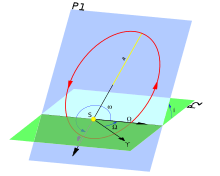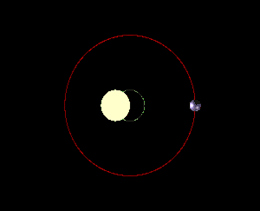Minimum mass
In astronomy, minimum mass is the lower-bound calculated mass of observed objects such as planets, stars and binary systems,[1] nebulae,[2] and black holes.
Right: In this case none of the star's movement is along the viewer's line-of-sight and the Doppler spectroscopy method will not detect the planet at all.
Minimum mass is a widely cited statistic for extrasolar planets detected by the radial velocity method or Doppler spectroscopy, and is determined using the binary mass function. This method reveals planets by measuring changes in the movement of stars in the line-of-sight, so the real orbital inclinations and true masses of the planets are generally unknown.[3] This is a result of Sin i degeneracy.
If inclination i can be determined, the true mass can be obtained from the calculated minimum mass using the following relationship:
It is likely that the smallest mass for a black hole is approximately the Planck mass (about 2.2×10−8 kg or 22 micrograms).
Exoplanets
Orientation of the transit to Earth

Most stars will not have their planets lined up and orientated so that they eclipse over the center of the star and give the viewer on earth a perfect transit. It is for this reason that when we often are only able to extrapolate a minimum mass when viewing a star's wobble because we do not know the inclination and therefore only be able to calculate the part pulling the star on the plane of celestial sphere.
For orbiting bodies in extrasolar planetary systems, an inclination of 0° or 180° corresponds to a face-on orbit (which cannot be observed by radial velocity), whereas an inclination of 90° corresponds to an edge-on orbit (for which the true mass equals the minimum mass).[4]
Planets with orbits highly inclined to the line of sight from Earth produce smaller visible wobbles, and are thus more difficult to detect. One of the advantages of the radial velocity method is that eccentricity of the planet's orbit can be measured directly. One of the main disadvantages of the radial-velocity method is that it can only estimate a planet's minimum mass (). This is called Sin i degeneracy. The posterior distribution of the inclination angle i depends on the true mass distribution of the planets.[5]
Radial-velocity method
However, when there are multiple planets in the system that orbit relatively close to each other and have sufficient mass, orbital stability analysis allows one to constrain the maximum mass of these planets. The radial velocity method can be used to confirm findings made by the transit method. When both methods are used in combination, then the planet's true mass can be estimated.
Although radial velocity of the star only gives a planet's minimum mass, if the planet's spectral lines can be distinguished from the star's spectral lines then the radial velocity of the planet itself can be found, and this gives the inclination of the planet's orbit. This enables measurement of the planet's actual mass. This also rules out false positives, and also provides data about the composition of the planet. The main issue is that such detection is possible only if the planet orbits around a relatively bright star and if the planet reflects or emits a lot of light.[6]
The term true mass is synonymous with the term mass, but is used in astronomy to differentiate the measured mass of a planet from the minimum mass usually obtained from radial velocity techniques.[7] Methods used to determine the true mass of a planet include measuring the distance and period of one of its satellites,[8] advanced astrometry techniques that use the motions of other planets in the same star system,[7] combining radial velocity techniques with transit observations (which indicate very low orbital inclinations),[9] and combining radial velocity techniques with stellar parallax measurements (which also determine orbital inclinations).[10]
Use of sine function

In trigonometry, a unit circle is the circle of radius one centered at the origin (0, 0) in the Cartesian coordinate system.
Let a line through the origin, making an angle of θ with the positive half of the x-axis, intersect the unit circle. The x- and y-coordinates of this point of intersection are equal to cos(θ) and sin(θ), respectively. The point's distance from the origin is always 1.

Stars
With a mass only 93 times that of Jupiter (MJ), or .09 M☉, AB Doradus C, a companion to AB Doradus A, is the smallest known star undergoing nuclear fusion in its core.[11] For stars with similar metallicity to the Sun, the theoretical minimum mass the star can have, and still undergo fusion at the core, is estimated to be about 75 MJ.[12][13] When the metallicity is very low, however, a recent study of the faintest stars found that the minimum star size seems to be about 8.3% of the solar mass, or about 87 MJ.[13][14] Smaller bodies are called brown dwarfs, which occupy a poorly defined grey area between stars and gas giants.
Black holes
In principle, a black hole can have any mass equal to or above the Planck mass (about 2.2×10−8 kg or 22 micrograms).[15] To make a black hole, one must concentrate mass or energy sufficiently that the escape velocity from the region in which it is concentrated exceeds the speed of light. This condition gives the Schwarzschild radius, R = 2GM/c2, where G is the gravitational constant, c is the speed of light, and M the mass of the black hole. On the other hand, the Compton wavelength, λ = h/Mc, where h is the Planck constant, represents a limit on the minimum size of the region in which a mass M at rest can be localized. For sufficiently small M, the reduced Compton wavelength (λ = ħ/Mc, where ħ is the reduced Planck constant) exceeds half the Schwarzschild radius, and no black hole description exists. This smallest mass for a black hole is thus approximately the Planck mass.
Some extensions of present physics posit the existence of extra dimensions of space. In higher-dimensional spacetime, the strength of gravity increases more rapidly with decreasing distance than in three dimensions. With certain special configurations of the extra dimensions, this effect can lower the Planck scale to the TeV range. Examples of such extensions include large extra dimensions, special cases of the Randall–Sundrum model, and string theory configurations like the GKP solutions. In such scenarios, black hole production could possibly be an important and observable effect at the Large Hadron Collider (LHC).[16][17][18][19][20] It would also be a common natural phenomenon induced by cosmic rays.
All this assumes that the theory of general relativity remains valid at these small distances. If it does not, then other, presently unknown, effects will limit the minimum size of a black hole. Elementary particles are equipped with a quantum-mechanical, intrinsic angular momentum (spin). The correct conservation law for the total (orbital plus spin) angular momentum of matter in curved spacetime requires that spacetime is equipped with torsion. The simplest and most natural theory of gravity with torsion is the Einstein–Cartan theory.[21][22] Torsion modifies the Dirac equation in the presence of the gravitational field and causes fermion particles to be spatially extended.[23]
The spatial extension of fermions limits the minimum mass of a black hole to be on the order of 1016 kg, showing that micro black holes may not exist. The energy necessary to produce such a black hole is 39 orders of magnitude greater than the energies available at the Large Hadron Collider, indicating that the LHC cannot produce mini black holes. But if black holes are produced, then the theory of general relativity is proven wrong and does not exist at these small distances. The rules of general relativity would be broken, as is consistent with theories of how matter, space, and time break down around the event horizon of a black hole. This would prove the spatial extensions of the fermion limits to be incorrect as well. The fermion limits assume a minimum mass needed to sustain a black hole, as opposed to the opposite, the minimum mass needed to start a black hole, which in theory is achievable in the LHC.[24]
References
- Kuchner, Marc J. (September 2004). "A Minimum-Mass Extrasolar Nebula". The American Astronomical Society. 612 (2): 1147–1151. arXiv:astro-ph/0405536. Bibcode:2004ApJ...612.1147K. doi:10.1086/422577.
- B. Arbutina (June 2007). "The minimum mass ratio of W UMa-type binary systems". Monthly Notices of the Royal Astronomical Society. 377 (4): 1635–1637. Bibcode:2007MNRAS.377.1635A. doi:10.1111/j.1365-2966.2007.11723.x.
- Rothery, David A.; Gilmour, Iain; Sephton, Mark A. (March 2018). An Introduction to Astrobiology. pp. 234–236. ISBN 9781108430838.
- Fleisch, Daniel; Kregenow, Julia (August 29, 2013). A Student's Guide to the Mathematics of Astronomy. pp. 97–101. ISBN 9781107610217.
- Stevens, Daniel J.; Gaudi, B. Scott (2013). "A Posteriori Transit Probabilities". Publications of the Astronomical Society of the Pacific. 125 (930): 933–950. arXiv:1305.1298. Bibcode:2013PASP..125..933S. doi:10.1086/672572.
- Rodler, Florian; Lopez-Morales, Mercedes; Ribas, Ignasi (2012). "Weighing the Non-Transiting Hot Jupiter Tau BOO b". The Astrophysical Journal. 753 (1): L25. arXiv:1206.6197. Bibcode:2012ApJ...753L..25R. doi:10.1088/2041-8205/753/1/L25.
- "McDonald Observatory astronomers discover Neptune-sized planet with Hobby-Eberly Telescope". University of Texas at Austin. August 31, 2004. Archived from the original on February 13, 2007. Retrieved September 4, 2007.
- Brown, Michael E.; Schaller, Emily L. (June 15, 2007). "The Mass of Dwarf Planet Eris". Science. 316 (5831): 1585. Bibcode:2007Sci...316.1585B. doi:10.1126/science.1139415. PMID 17569855.CS1 maint: ref=harv (link)
- "How do we know the density of some extrasolar planets?". Curious About Astronomy?. Archived from the original on October 12, 2007. Retrieved September 8, 2007.
- Han, Inwoo; Black, David C.; Gatewood, George (2001). "Preliminary Astrometric Masses for Proposed Extrasolar Planetary Companions". The Astrophysical Journal Letters. 548 (1): L57–L60. Bibcode:2001ApJ...548L..57H. doi:10.1086/318927.
- "Weighing the Smallest Stars", European Southern Observatory Press Release, ESO: 2, January 1, 2005, Bibcode:2005eso..pres....2., retrieved August 13, 2006.
- Boss, Alan (April 3, 2001), Are They Planets or What?, Carnegie Institution of Washington, archived from the original on September 28, 2006, retrieved June 8, 2006.
- Shiga, David (August 17, 2006), Mass cut-off between stars and brown dwarfs revealed, New Scientist, archived from the original on November 14, 2006, retrieved August 23, 2006.
- Hubble glimpses faintest stars, BBC, August 18, 2006, retrieved August 22, 2006.
- Hawking, Stephen W. (1971). "Gravitationally collapsed objects of very low mass". Monthly Notices of the Royal Astronomical Society. 152: 75. Bibcode:1971MNRAS.152...75H. doi:10.1093/mnras/152.1.75.
- Carr, B. J.; Giddings, S. B. (2005). "Quantum black holes". Scientific American. 292 (5): 48–55. Bibcode:2005SciAm.292e..48C. doi:10.1038/scientificamerican0505-48. PMID 15882021.
- Giddings, S. B.; Thomas, S. D. (2002). "High-energy colliders as black hole factories: The End of short distance physics". Physical Review D. 65 (5): 056010. arXiv:hep-ph/0106219. Bibcode:2002PhRvD..65e6010G. doi:10.1103/PhysRevD.65.056010.
- Dimopoulos, S.; Landsberg, G. L. (2001). "Black Holes at the Large Hadron Collider". Physical Review Letters. 87 (16): 161602. arXiv:hep-ph/0106295. Bibcode:2001PhRvL..87p1602D. doi:10.1103/PhysRevLett.87.161602. PMID 11690198.
- Johnson, George (September 11, 2001). "Physicists Strive to Build A Black Hole". The New York Times. Retrieved May 12, 2010.
- "The case for mini black holes". CERN Courier. November 2004.
- Sciama, Dennis W. (1964). "The physical structure of general relativity". Reviews of Modern Physics. 36 (1): 463–469. Bibcode:1964RvMP...36..463S. doi:10.1103/revmodphys.36.463.
- Kibble, Tom W. B. (1961). "Lorentz invariance and the gravitational field". Journal of Mathematical Physics. 2 (2): 212–221. Bibcode:1961JMP.....2..212K. doi:10.1063/1.1703702.
- Popławski, Nikodem J. (2010). "Nonsingular Dirac particles in spacetime with torsion". Physics Letters B. 690 (1): 73–77. arXiv:0910.1181. Bibcode:2010PhLB..690...73P. doi:10.1016/j.physletb.2010.04.073.
- Stephen Hawking, "new doomsday warning"

